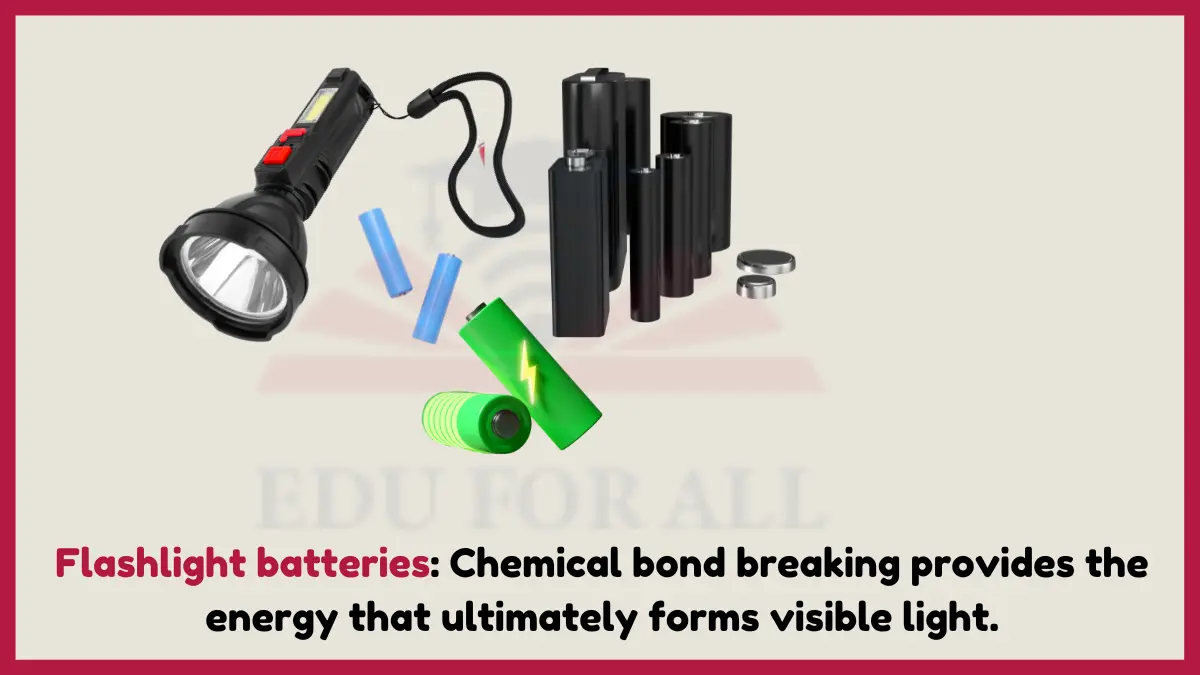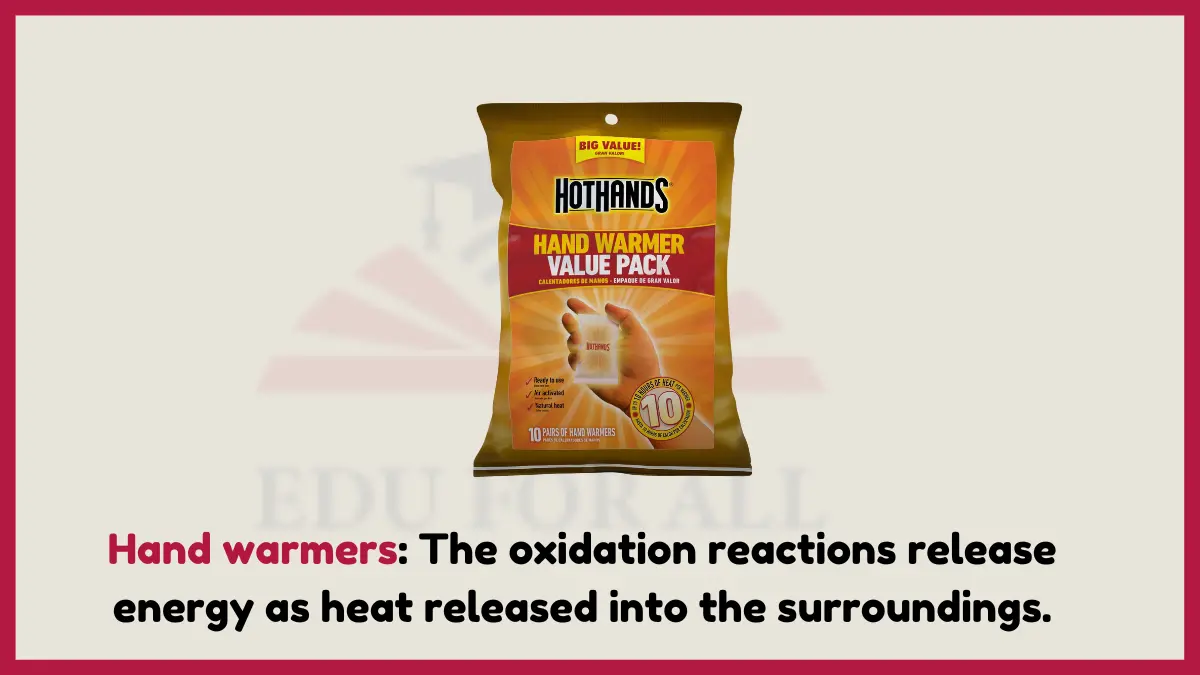Chemical energy is the energy stored in the bonds of atoms and molecules. It is a versatile form of energy that can be converted into other forms, such as thermal energy, light energy, and electrical energy. Examples of chemical energy in action include the explosion of a firecracker, the heat generated by a hot pack, the energy that powers a flashlight, the burning of wood in a fireplace, and the food we eat.
Examples of Chemical Energy
Here are the 10 examples of chemical energy:
1. Burning Wood
Wood contains abundant chemical energy stored in the bonds of its organic molecules like cellulose and lignin. When wood is ignited and burns, these compounds rapidly undergo combustion reactions with oxygen that break apart their chemical bonds.
This releases the stored energy as visible light and heat that is felt as fire. Burning wood converts stored chemical energy into thermal and light energy.

Experiment: Burn a small piece of wood like a twig or matchstick. Feel the heat and observe the flame and light produced.
2. Baking Soda and Vinegar Reaction
Mixing baking soda and vinegar is a fun reaction to demonstrate a chemical energy transformation. The acetic acid in vinegar reacts with sodium bicarbonate in baking soda, breaking and forming chemical bonds as carbon dioxide gas is rapidly produced.
This exothermic reaction gives off heat energy that can be felt as the liquids bubble up. The stored chemical energy in the original molecules gets converted into thermal energy and motion energy as bubbles.

Experiment: Add baking soda to vinegar and watch it bubble up. This reaction gives off heat energy that can be felt on your hand.
3. Flashlight Batteries
Flashlight batteries provide a simple way to observe chemical energy being converted into light and electricity. Battery cells contain electrochemical reactions that produce a potential difference across terminals.
When the circuit is completed, oxidation-reduction reactions give off electrons that power the light bulb. So chemical bond breaking provides the energy that ultimately forms visible light.

Experiment: Use fresh batteries in a flashlight. Switch it on and observe the light. The battery’s chemicals are reacting to produce light.
4. Cooked Food
Cooking food is an everyday example of using energy to transform chemical bonds and make energy stored in food available. Raw foods like eggs, meat, and potatoes contain complex molecules our bodies cannot readily digest.
Applying heat breaks down proteins, fats, and starches into simpler compounds. Cooking chemically transforms the food molecules into an energy source we can access.

Experiment: Compare cooked versus raw foods like eggs or potatoes. Cooking changes their chemistry and makes energy accessible.
5. Firecrackers
The explosion of a firecracker is a prime example of chemical energy being transformed into sound and light energy. When a firecracker explodes, the loud bang results from an extremely rapid release of chemical energy. Compounds like nitrocellulose and oxidizers packed into the firecracker undergo fast combustion when ignited, breaking their bonds violently.
This produces a pressure wave we hear as sound and light from the heat. The chemicals in firecrackers store energy that is quickly converted through decomposition reactions.

Experiment: Set off a firecracker (with an adult!) and observe the loud bang – evidence of rapid chemical energy release.
6. Hot and Cold Packs
Hot and cold packs demonstrate endothermic and exothermic chemical reactions that absorb or release heat energy. The packs contain two separate pouches with reactants that, when mixed, either break down bonds exothermically to produce heat or absorb heat as new bonds form endothermically.
In both cases, chemical potential energy is converted into the transfer of thermal energy.

Experiment: Activate a hot or cold pack and feel it heat up or cool down as chemical reactions occur.
7. Hand Warmers
Reusable hand warmers provide lasting heat because of ongoing chemical reactions that release energy. The warmers contain iron powder, water, salt, activated charcoal, and exposure to oxygen in air initiates oxidation reactions when the warmer is opened.
As the iron rusts slowly, it converts chemical energy stored in molecular bonds into heat released into the surroundings.

Experiment: Open a hand warmer package and feel it get hot. This shows a chemical reaction taking place as energy is released.
8. Gasoline Combustion
The energy in gasoline and other hydrocarbon fuels comes from the chemical bonds between carbon and hydrogen atoms that make up their molecules.
When combusted in an engine, these compounds undergo violent reactions with oxygen, rapidly breaking apart the bonds and forming new bonds. This releases copious amounts of chemical energy that engines convert into automobile motion.

Experiment: Observe gasoline being used to power cars and trucks. The fuel’s energy moves the vehicles.
9. Glow Sticks
Glow sticks offer an exciting way to see chemical energy converted into radiant light energy. The sticks contain two separate reactants in a plastic tube. When the tube is bent, the chemicals mix, initiating reactions as electrons get promoted into high energy states.
As they fall back down, photons are emitted as visible light. The chemical reaction absorbs energy to produce glowing light.

Experiment: Snap a glow stick to mix its inner chemicals. It will glow due to reactions giving off energy as light.
10. Citric Acid and Baking Soda
Citric acid and baking soda reacting is an easily doable demonstration of chemical energy being released in an exothermic reaction. When mixed, the citric acid provides protons needed to generate carbonic acid from sodium bicarbonate.
As carbon dioxide forms, new water bonds also release energy detected as bubbling and warmth.

Experiment: Mix citric acid powder with baking soda and watch it fizz and bubble as carbon dioxide is produced and heat given off.

